Aeka Ishihara, Professor, Faculty of Business and Commerce
The many facets of Johann Wolfgang von Goethe
– Giving Goethe new substance as a “natural scientist” –
Aeka Ishihara
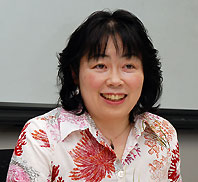
BA in German Literature, Faculty of Letters, Keio University in 1992. MA, Graduate School of Letters, Keio University in 1994. PhD, University of Cologne, Germany in 1998.
Assistant Professor in the Faculty of Business and Commerce, Keio University in 1999, Associate Professor in 2002, and Professor in 2008.
Awarded the 2005 Jacob and Wilhelm Grimm Advancement Award by the German Academic Exchange Service (DAAD) for her studies on the theme of Goethe and modern natural sciences. Also won the 3rd JSPS (Japan Society for the Promotion of Science) Prize and the Japan Academy Medal in 2007 for her publication Goethes Buch der Natur (Goethe's Book of Nature).
Translations include H. J. Kreutzer, Faust: Mythos und Musik (2007) and M. Osten, Alles veloziferisch oder Goethes Entdeckung der Langsamkeit (2009). Won the 32nd Suntory Academic Award (Art & Literature) for her Kagaku suru Shijin Gete (Goethe, Poet and Scientist) published in 2010.
From interest in the Bildungsroman to research on Goethe
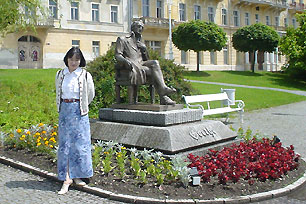
— What first made you want to study German literature and Goethe in particular?
I was fond of Japanese classics at senior high school, and so my teacher there recommended I study Japanese literature at Keio. But soon after entering Keio, I came across the German course at Hiyoshi, and decided to major in German literature.
Of all German literature, I was particularly interested in the “Bildungsroman” genre. These are novels in which the protagonist achieves self-realization by going through various experiences. Goethe's Wilhelm Meisters Lehrjahre (Wilhelm Meister's Apprenticeship) and the sequel Wilhelm Meisters Wanderjahre (Wilhelm Meister’s Journeyman Years) are typical examples. But Goethe's works use antiquated language and orthography, and this made them hard for undergraduates to read. I therefore chose the Bildungsroman Das Glasperlenspiel (The Glass Bead Game) by Hermann Hesse for my graduation thesis. I then moved on to graduate school with the desire to study the protagonists of Goethe's works, called “Meister” (master) in contrast to Hesse's protagonist “Knecht” (servant).
─ How did you come to focus on Goethe and the natural sciences?
In continuing my research on Goethe in my PhD course, I wanted to avoid so-called hermeneutic research, i.e. study of the theory and practice of interpretation. I felt that research on Goethe in the purely literary field had been more or less covered already, and it was difficult to find an original angle. After all, this is a field where reference literature on the works of Goethe alone can easily take up about 20 meters of a library's shelves.
I had always been interested in natural sciences. At senior high school I belonged to the geology club, and observed sunspots every day. At university, too, I joined an astronomy circle and used to photograph the heavens from the car park at the 5th station of Mount Fuji. With these experiences, I started thinking about linking Goethe with astronomy in my research.
Goethe was not only a poet but also a high-ranking bureaucrat in the Duchy of Saxe-Weimar, where he even rose to the position of Chancellor. At the same time, he was a keen natural scientist. He gathered and analyzed a massive natural science collection, and even wrote dissertations in the field of natural sciences. What's more, he actively incorporated his new-found scientific knowledge in his literary works. Goethe's later works, such as Die Wahlverwandtschaften(Elective Affinities), Wilhelm Meisters Wanderjahre (Wilhelm Meister's Journeyman Years) and Faust: Der Tragödie zweiter Teil(Faust Part II ), are full of reference to chemistry, medicine, mathematics, astronomy, mineralogy and knowledge of other fields. I felt that, if I could focus on the relationship between Goethe and the leading-edge scientific knowledge of his day, I would find a new theme.
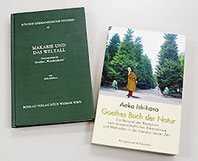
─ What kind of research did you pursue in your PhD course?
While enrolled in the graduate school at Keio, I went for a period of study at the University of Cologne in Germany. There, I started researching the relationship between Goethe and modern natural sciences in earnest.
In the era when Goethe was alive, between the 18th and 19th centuries, astronomy split off from traditional astrology to join the ranks of modern sciences that depended on telescopes and mathematics. In Wilhelm Meisters Wanderjahre (Wilhelm Meister’s Journeyman Years), Goethe introduces the elderly noblewoman Makarie, who has a close affinity with astronomy. In conventional studies on Goethe, she has only been interpreted in terms of mystical aspects, without any consideration of the prevailing scientific background.
In contrast to this, I wanted to analyze her character not from the perspective of astrology but from that of modern astronomy. Makarie und das Weltall (Makarie and the Universe), a reworking of my degree thesis submitted to the University of Cologne, was my first publication in German.
Praise for a thesis written through the eyes of a foreign culture
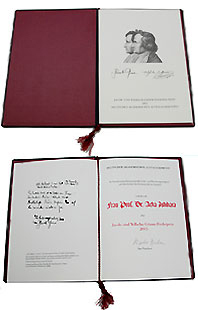
─ How did people in Germany react to the idea of linking Goethe with science?
When I first approached my supervisor Professor Irmscher with the idea of a thesis on Goethe and modern astronomy, he encouraged me, saying “It could be interesting, give it a try.” To write my PhD thesis, I had to keep going to the research library in Weimar. There was even a rumor that "A postgrad from Japan is foraging day and night for information on Goethe and science".
Foreigners who go to study German literature in Germany often want to obtain degrees in areas such as the history of Goethe’s acceptance in their own countries, or comparative research with literary works in their own languages. But my approach was different; rather than cross-cultural research, I wanted to pursue research on the same footing as German graduate students. As a result, one of the professors who reviewed my PhD thesis said “She may be Japanese, but her thesis is written through the approach of a new academic facet”. I was really happy to be praised in this way.
─ What kind of research did you pursue in your PhD thesis?
My supervisor Professor Irmscher advised me that the next thesis after my PhD would be the important one. In 2005, I published an academic volume in German under the title Goethes Buch der Natur (Goethe's Book of Nature), dealing with six fields on Goethe and natural sciences not included in my PhD thesis – geology, astronomy, physics, chemistry, botany and zoology. I was awarded the Jacob and Wilhelm Grimm Advancement Award by the German Academic Exchange Service (DAAD) for this book. This gave me the confidence to continue my research on the theme of Goethe and modern natural sciences.
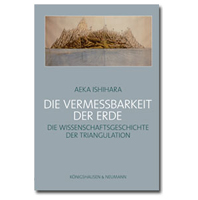
─ And since then, you've continued your research on Goethe and science?
Yes, in 2009 I was awarded a scholarship by the Alexander von Humboldt Foundation in Germany. This allowed me to pursue concentrated research on Goethe’s relationship with surveying, a form of applied mathematics in his day. I was based at the University of Jena, where Goethe served as dean. In his long novel
Die Wahlverwandtschaften (Elective Affinities), for example, he introduces a character called “the Captain” who practices trigonometric surveying, or triangulation. I have already referred to this in Chapter 5 of my Kagaku suru Shijin Gete (Goethe, Poet and Scientist), published in spring 2010. But now I have further expanded and amplified this chapter, and in spring this year I finished my third academic work in German. It deals with the history of modern triangulation in Europe and Japan, with particular focus on triangulation in Goethe’s day. This was published in Germany in August 2011.
─ What particularly attracts you to research on Goethe and science?
When Goethe was born, the natural sciences had not yet branched off into specialized disciplines, so that even laymen like Goethe could engage themselves in science. In an age without television or radio, literature acted as a medium for propagating scientific information. It was a kind of honeymoon period for literature and science.
This was also an era in which links between science and women came into focus. Although they were few, female astronomers were active; the most notable being Caroline Herschel. Her older brother William famously discovered the planet Uranus, but she herself discovered several comets. Also around this time, the French philosopher Fontenelle wrote his scientific treatise Entretiens sur la Pluralité des Mondes (Conversations on the Plurality of Worlds), which became a bestseller. This is a charming introduction to science in which an astronomer explains the latest astronomical wisdom to a highly intelligent noblewoman over six successive evenings, while strolling in a French garden and gazing up at the night sky. After the French Revolution, the idea that women should stay at home became mainstream, and university doors were closed to them. Nevertheless, this was a time, albeit fleeting, in which women and science were rapidly drawn together. To me, this is a very interesting episode in the history of science.
Ambitions for broader writing on Japan-German medical exchanges
— Please tell us about your plans for future research.
As I said earlier, I have consciously avoided research of a cross-cultural nature until now. However, partly because my work so far has been fairly well received, I would like to focus on writing about links between Germany and Japan from now on.
Medical exchanges between Japan and Germany in the Meiji era provide a particularly attractive theme. For example, it would be really attractive to research Mizuko Takahashi, the first female doctor who went to study in Germany in those days. Here was a woman of great energy who once went on hunger strike for three days and three nights outside Saiseigakusha, a private medical college in Tokyo, in protest at its exclusion of women. Even after she joined the medical profession, she went to Berlin in the hope of studying her special field of obstetrics and gynecology. There, she was supported by her landlady, a Japanophile, and even managed to attend lectures at the University of Berlin, where no women at all were admitted at the time.
— Were there any other pioneering women like that in the Meiji era?
Yes, there was a woman called Tada Urata, a pupil of Shibasaburo Kitasato who went to study in Marburg. She was not only the first Japanese woman but the first woman of any nationality, including Germans, to obtain a PhD in medicine at Marburg. Then there was Yayoi Yoshioka, a junior of Mizuko Takahashi at Saiseigakusha. She wanted to establish a medical college for women only, and with the help of her husband Arata, succeeded in founding Tokyo Women's Medical School, forerunner of the Tokyo Women's Medical University. Today, Tokyo Women's Medical University houses the skeletal specimens of Mizuko Takahashi herself, bequeathed in her will for the furtherance of medical education, and just the other day, I was given special permission to see them. At the same time, the presence of so many people who supported those women is also very interesting.
There are so many things I want to write about these Japan-German medical exchanges. Actually, I'm in the middle of preparing them for my next book right now.
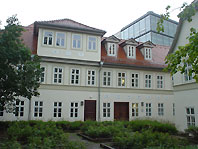
— How does this research relate to Goethe?
Well, for example, Goethe has a connection with modern medicine. Koan Ogata, who as everyone knows founded the Tekijuku school and had a huge impact on the modernization of Japan, made it his life's work to translate Enchiridion Medicum by the German physician C.W. Hufeland. In fact, this Hufeland was Goethe’s personal doctor. One of his early works was Makrobiotik oder Die Kunst, das menschliche Leben zu verlängern (Macrobiotics or the Art of Prolonging Life), and in Der Mann von fünfzig Jahren (The Man of Fifty Years), a novella in Goethe’s Wilhelm Meisters Wanderjahre (Wilhelm Meister’s Journeyman Years), the theme of rejuvenation is discussed. This is just one recognizable example of Hufeland's influence. And if we consider that one of the students at Tekijuku was Yukichi Fukuzawa, there does seem to be a strange connection between Goethe and Keio University.
— Finally, could you define Goethe's significance for the modern age?
Goethe’s Der Zauberlehrling (The Sorcerer's Apprentice) is a poem in which a sorcerer’s apprentice imitates his master to conjure up a spell that makes a broom fetch water. But the apprentice forgets the vital spell needed to stop the water, the workshop is consequently flooded and he has to ask his master to stop it. This poem is usually interpreted as highlighting the difference between knows and know-nots, but has also been referred to in connection with various social themes such as environmental problems. The recent accidents at nuclear power plants following the East Japan catastrophe spring to mind here. The sayings of Goethe tend to be popular in Japan, but in Germany, his poems and novels are often cited when discussing the problems of contemporary society. I think the real thrill of Goethe's works is that they can be read in various ways, even for us in the modern era.
*This article appeared in "Kenkyu Saizensen" (Jul. 1, 2011) of Keio University Japanese Website.
